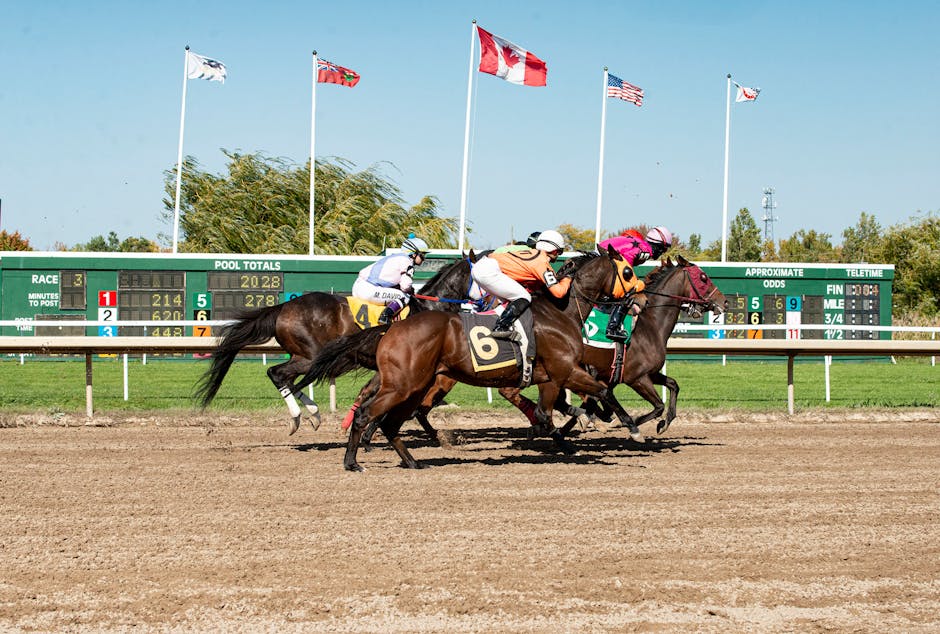Understanding the Basics of Horse Racing Odds
Odds in horse racing do two things: they tell you how much money you stand to win, and they give a rough idea of a horse’s chance of winning. But here’s the catch odds aren’t pure probability. They’re shaped by both bookmaker insight and where the public is putting its money.
Let’s say a horse is listed at 5 to 1. That means for every $1 you bet, you get $5 in profit if the horse wins, plus your original stake back. But those odds also imply around a 16.7% chance of success though not carved in stone.
You’ll come across three main types of odds formats:
Fractional (e.g., 5/1, 10/3, 7/2): Most common in the UK. The first number tells you what you’ll win, the second is what you wager. So 5/1 means win $5 for every $1 bet.
Decimal (e.g., 6.00, 2.50, 9.75): Popular in Europe and increasingly common online. Multiply your stake by the decimal to get what you’ll be paid out your original stake is already included. A 2.50 odds means a $10 bet pays $25 total.
American (e.g., +250, 150): Less intuitive at first. Positive numbers show how much you’d profit on a $100 bet (+250 means you’d win $250). Negative numbers show how much you need to bet to win $100 ( 150 means you’d have to wager $150).
Odds change constantly. They shift based on how bettors are wagering more money on a horse makes its odds shorter (less reward, but implies more confidence). They also adjust for new info, like rider changes, weather, or big tips moving through the betting markets. Bookmakers also tweak odds to protect margins and balance their books.
Bottom line: odds aren’t just numbers. They’re signals. Learn to read them, and you’ll get a sharper view of both the race and the risk.
Fractional Odds: The Traditional Format
Fractional odds are the traditional and most common format used in the UK and Ireland. While they might appear confusing at first, they are relatively simple once you understand the basic math behind them.
What Do Fractional Odds Look Like?
Fractional odds are displayed as two numbers separated by a slash or hyphen, such as:
5/1 (five to one)
10/3 (ten to three)
7/2 (seven to two)
These odds show the ratio of profit to the stake.
What You Win vs. What You Stake
The first number tells you how much you’ll profit if you bet the amount shown by the second number.
5/1: For every $1 you bet, you win $5 (plus your original stake back)
10/3: For every $3 you bet, you win $10
7/2: For every $2 you bet, you win $7
You always get your original stake back in addition to your winnings.
Quick Math to Assess Profit
You don’t have to be a math whiz to use fractional odds effectively. Here’s how beginners can think about it:
Step 1: Divide the first number by the second number to get the potential return per dollar bet.
Step 2: Multiply that number by your stake to calculate profit.
Example:
Odds: 9/2 → That’s a profit of $4.50 per $1 bet
If you stake $10: 4.5 × 10 = $45 profit, plus your $10 back for a total of $55
When to Use Fractional Odds
Fractional odds are especially useful when comparing potential value between horses. Once you get the hang of interpreting them quickly, they offer clear insight into your possible return relative to the bookmaker’s perceived chance of a win.
Decimal Odds: The Simplified Approach
If you’re just getting into horse racing, decimal odds are probably the easiest to wrap your head around. They tell you right away how much you’ll get back for every dollar you bet including your original stake.
Say you see odds of 6.00 on a horse. That means if you bet $1, your total return will be $6. Bet $10, you get $60 back (that’s $50 profit and your $10 stake returned). Odds of 2.50 will return $2.50 for every $1, and 9.75 means $9.75 back per $1. Simple multiplication no fractions, no extra math.
This format is common in places like Australia and Europe, and it’s spreading in popularity because of how beginner friendly it is. You don’t have to figure out what 7/2 means. You just look at the number, do the math, and know what to expect.
For new bettors who want clarity and quick decisions, decimal odds cut through the noise. They’re clean, fast, and give you the full picture in a single glance.
American Odds: The Plus and Minus System

American odds can look intimidating at first especially with the pluses and minuses but they’re actually pretty straightforward once you get the hang of it.
Here’s how it breaks down:
A plus sign (+) means you’re looking at an underdog. For example, if a horse has +250 odds, that means a $100 bet would win you $250 in profit. So you’d get $350 back total (your $100 stake plus $250 winnings).
A minus sign (−) means the horse is a favorite. So if you see −150, that means you need to bet $150 to win $100. Your return would be $250: your original $150 plus a $100 gain.
Put another way: positive odds show you how much you’d win on a $100 bet. Negative odds show how much you have to risk to win $100.
Understanding these odds is all about gauging risk versus reward. Backing a +250 underdog might offer a strong payout, but that horse isn’t expected to win most of the time. On the flip side, a −150 favorite has a better shot, but you’re risking more to get a smaller return.
Compared globally, American odds are less intuitive than decimal odds but can be more helpful when you’re comparing favorites and underdogs side by side. Once you’re used to them, they give you a quick feel for who’s expected to perform and how much bang you get for your buck.
Whether you’re betting casually or trying to sharpen your edge, learning to read this format properly is key it’s the standard in most U.S. sportsbooks and racing sites.
How Value Plays a Role in Odds
Not all horses are priced fairly. Sometimes the crowd jumps too hard on a favorite, pushing the odds too low to be worth the risk. Other times, a horse with strong hidden potential goes under the radar, and the payout doesn’t match the real chance of a win. That’s where spotting value becomes a serious edge.
Value betting isn’t about guessing long shots. It’s about finding horses whose odds misrepresent their true chances. Say a horse is listed at 8/1, but after reviewing form, conditions, and past races, you believe its real chance of winning is closer to 1 in 5. That’s a value bet. It won’t always win but over time, these plays compound into profit.
Odds alone are just one layer. They reflect public sentiment, not raw data. If bettors favor flashy names or emotional picks, real value can show up in the quieter, overlooked runners. Smart bettors learn to see around the crowd’s bias and that’s where profit tends to live.
How Odds Tie Into Smarter Strategies
Context Matters: Odds Aren’t the Whole Story
Horse racing odds tell you part of the picture but smart bettors look beyond just the numbers. To build well informed bets, you must evaluate the odds in light of other race day variables:
Key Factors to Consider
Form: Is the horse coming off a streak of wins or poor performances?
Distance: Has the horse excelled or struggled at this distance in the past?
Track Conditions: Mud, turf, or fast track each influences how different horses perform.
Jockey & Trainer Records: Consistent success often comes from experienced partnerships.
Odds reflect how the public and bookmakers interpret these variables. But digging into the details yourself gives you a sharper edge.
Finding the Balance Between Risk and Reward
Higher odds can be tempting but they often signal a lower perceived chance of winning. The key is to balance risk with logical confidence in your pick.
Smart Risk Management Guide:
Don’t chase long shots blindly assess form and past performance.
Spread your bets on races where odds and data align.
Use smaller wagers on high risk, high reward picks to preserve bankroll.
Go Deeper Into Strategy
Odds are just one tool in your betting toolbox. To refine your approach:
Focus on consistency and long term gains, not just big wins.
Adjust your strategy based on race type, field size, and market behavior.
Track your results to learn what works
Want to sharpen your betting acumen even more? Dive deeper into these horse racing strategies to elevate your game beyond the basics.
Final Takeaways For First Timers
Before you throw money at the starting gate, double check the odds. They’re not just numbers they’re signals. Lines shift subtly as bets come in, and what looked decent an hour ago could have drifted into poor value territory.
But odds aren’t gospel, either. They’re just part of the puzzle. Don’t get tunnel vision. Form, trainer stats, jockey changes, conditions dig into the full picture before making your move. Think of odds as one of several gauges, not the final word.
And here’s the hard truth: emotion kills bankrolls. Don’t fall for names you like or shots in the dark because “you’ve got a feeling.” Study what works. Look for horses that align with consistent patterns. Know your metrics, trust logic over gut, and don’t chase bets to win back losses.
Want to tighten your game even more? These horse racing strategies give you an edge beyond the basics.

 Sherrylaines Merrill, a pivotal force in the project, brought unmatched leadership and creative direction to Bet Roll Gamble. Her deep understanding of the betting industry, combined with an innovative vision, ensured the platform offers not only valuable content but also resonates with its audience. Sherrylaines played a key role in aligning the platform’s strategy with user needs, creating a resource that is both insightful and practical.
Sherrylaines Merrill, a pivotal force in the project, brought unmatched leadership and creative direction to Bet Roll Gamble. Her deep understanding of the betting industry, combined with an innovative vision, ensured the platform offers not only valuable content but also resonates with its audience. Sherrylaines played a key role in aligning the platform’s strategy with user needs, creating a resource that is both insightful and practical.